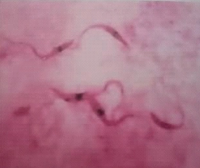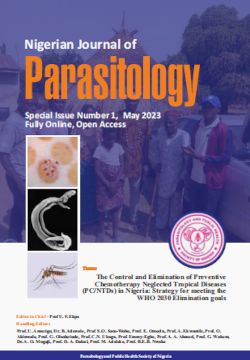The Prevalence of <i>Trypanosoma</i> species in Cattle in Calabar Metropolis of Cross River State in Southern Nigeria
DOI:
https://doi.org/10.4314/njpar.v45i1.16Keywords:
Trypanosoma, Prevalence, Glossina, Cattle, BloodAbstract
This study was conducted to determine the prevalence of Trypanosoma species in cattle due to the increasing movement of animals within the metropolis. Blood specimens were collected from 1200 cattle during slaughter at four abattoirs (Bogobiri, Nasarawa, Ibesikpo, and Ikot Eneobong) between February and May 2022. Dry universal containers were positioned in the stream of blood oozing from the cut neck of each cow. From these containers, 4 mL of blood was aspirated into an ethylenediamine-tetra-acetic acid (EDTA) bottle using a 5 mL syringe. Blood specimens were processed for microscopy at the Parasitology Laboratory of the University of Calabar Teaching Hospital. Wet preparation of each specimen was performed and examined for motile haemoparasites. Triple centrifugation was performed on 2 mLof each blood specimen at increasing speeds of 1000, 1500, and 3000 revolutions per minute for 5 min. During each centrifugation process, the resulting plasma was harvested and re-centrifuged. Finally, the resulting buffy coat layer and deposit were resuspended and used to prepare smears on clean microscope slides. After drying in air, blood smears were stained with 3% Giemsa solution for 30 min. The microscopy results showed that 570 stained blood specimens were positive for Trypanosoma species, which
morphologically resembled Trypanosoma brucei because of their long free flagellum. The overall prevalence of trypanosomes in cattle was 47.5%. Of the total number of infected cattle, 330 were males and 240 were females. The prevalence rates in male and female cattle were 27.5% and 20 %. There was no statistical difference in the occurrence of trypanosomes in the male and female cattle (X = 9.41; p > 0.05). However, the findings suggest that male cattle tend to forage more into the bush and are thus more likely to be exposed to bites of infected Glossina flies than their female counterparts. The high prevalence of trypanosomes in cattle, as shown in this study, may have major epidemiologic significance, considering the increasing rate of open grazing by cattle within residential areas in major cities all over Nigeria.
References
Fèvre, E. M., Wissmann, B., Welburn, S. C., and Lutumba, P. (2008). The burden of human African trypanosomiasis. PLOSNeglected Tropical Diseases, 2: e 333. http://dx.doi.org/10.1371/journal.pntd.0000333.
Welburn, S. C., Coleman, P. G., Maudlin, I., Fèvre, E. M., Odiit, M. and Eisler, E. C. (2006). Crisis, what crisis? Control of Rhodesian sleeping sickness. Trends in Parasitology, 22: 123-128.
Raadt, P. (2018). Human Africantrypanosomiasis: the history of sleeping sickness. World Health Organization 1-5. (https://who.int/news.room) Retrieved on 2 May, 2023.
MacLean, L. M., Odiit, M., Chisi, J. E., Kennedy, P. G. E., and Sternberg, J. M. (2010). Focus on specific clinical profiles in Human African Trypanosomiasis caused by Trypanosoma brucei rhodesiense. PLoS Neglected Tropical Diseases, 4(12), 1-13.
Institute for International Cooperation for Animal Biologics. (2009). Nagana, Tsetse fly disease. African Animal Trypanosomiasis 1-5.
www.cfsph.iastate.edu Retrieved on 2 May 2023.
Centers for Disease Control and Prevention. Pararsites-African Trypanosomiasis ( also known as Sleeping Sickness. Centers for Disease Control and Prevention. https://www.cdc.gov>parasites>sleepingsickness
Moloo, A. (2017). Chagas’ disease (South American trypanosomiasis). World Health Organization Fact Sheet 1-4. https://journals.plos..org>plosntds>article 10th December,2023.
Pépin J., and Meda, H. A. (2001). The epidemiology and control of human African trypanosomiasis. In J.R. Baker, R. Muller, and D. Rollinson (Eds.), Advances in Parasitology, (49) New York: Academic Press, 71-132.
Goodwin, L. G. (1964). The chemotherapy of trypanosomiasis. In S. M. Hutner (Ed.) The biochemistry and physiology ofprotozoa. New York Academic Press, Inc. (495-524).
Jennings, F. W., Urquhart, G. M., Murray, P. K. and Miller, B. M. (1980). “Berenil” and Nitroimidazole combinations in the treatment of Trypanosoma brucei infection with central nervous system involvement. International Journal of Parasitology,(10):27-32.
World Health Organization (2023).Trypanosomiasis, human African (sleeping sickness). https://www.int>int>newssroom>fact-sheets. Retrieved 10th December,2023.
Cheesbroough, M. (1987). Trypanosomes. Medical Laboratory Manual for Tropical Countries 1: 252-271. Butterworth & Co. Publishers Limited Borough Green, Sevenoaks, Kent TN15 8PH.
Hunter, G. W., Clyde, S. J. and David, F. C.(1978). Tropical Medicine Fifth Edition, Saunders Company Philadelphia, 72 -78.
Schmidt, G. D., Roberts, L. S. and Janovy, J. Jr. (2010). Genus Trypanosoma In: Foundations of Parasitology, McGraw-Hill Companies, Incorporated, 1221 Avenue of the Americas, New York, N.Y. 10020: 64-69.
Gordon, R. M. and Lavoipierre, M. M. J.(1978). The collection of arthropods of medical importance. In: Entomology for Students of Medicine, Blackwell Scientific Publications, North Baldwyn, Victoria, Australia: 1978, 288-292.
Usman, S. B., Babatunde, O. O., Oladipo, K. J., Felix, L. A. G., Gutt, B. G. and Dongkum, C. (2008). Epidemiological survey of animal trypanosomiasis in Kaltungo Local Government Area, Gombe State, Nigeria. Protozoology Research, (18): 96-105.
Ahmed, A. (2004). A peridomesticpopulation of the tsetse fly Glossina palpalis palpalisRobineau-Desvoidy, 1830 (Diptera: Glossinidae) at Kontagora town, Niger state, Nigeria. Entomología y Vectores, 11(4): 599-610, https://doi.org/10.1590/S0328-03812004000400004
Ajibade, W. A. and Agbede, S. A. (2008). Tsetse fly species diversity in Kainji Lake National Park, Nigeria. African Journal of Agricultural Research, (3), 753-758.
Ogedegbe, A. B. O. and Rotimi, J. (2017). A survey of tsetse flies (Glossina species) in the Niger Delta area, Southern Nigeria. African Journal of Environmental Pollution and Health, 2006 (5), 68-73.
Oyekwelu, C. K., Ejezie, E. F., Eze, A. A., Ikpekpeazu, E. J., Isaac, C., Ibegbu, M. D., and Ogbunude, P. O. (2017). Molecular identification of trypanosomes in the tsetse flies trapped from Onicha Ugbo in Delta State of Nigeria. Biomedical Research, (28), 5463-5467.

Downloads
Published
How to Cite
Issue
Section
License
Copyright (c) 2024 Nigerian Journal of Parasitology

This work is licensed under a Creative Commons Attribution-NonCommercial-NoDerivatives 4.0 International License.




